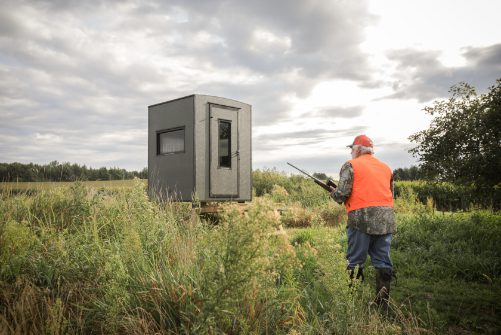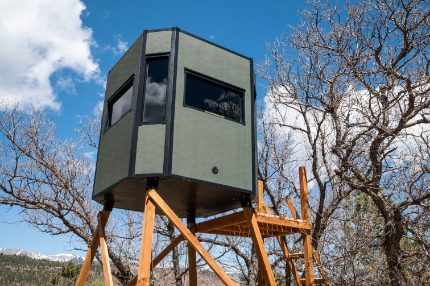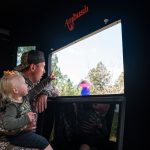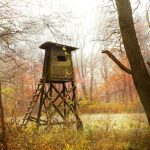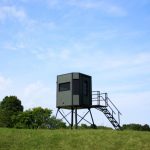Where to Place Your Hard-Sided Blinds
Do you know where you’re setting up your hard-sided blinds this deer hunting season? Early general deer seasons are just around the corner, so it’s time to start finding locations! Unlike hub-style pop-up ground blinds, hard-sided blinds are not usually brushed in.
Therefore, giving deer time to acclimate to your “little house on a stand” could mean the difference between success and going home empty-handed. Allowing enough time for deer to get used to a hard-sided blind, not to mention letting the area settle after setting up, is important.
Many experts suggest setting blinds up 3-6 weeks in advance. This is great practice on private land but is usually not achievable on public land due to time restrictions on stands and blinds. Just do the best you can to get your hard-sided blind set up as far in advance as your local laws will allow.
After years of testing and observing, we’ve found some of the best set-ups to optimize for success. Rarely is anything in hunting a slam-dunk every time, but these locations have stood the test of time (learn more about the history of hunting blinds here). Before delving into the locations, let’s talk about why you would want to use a hard-sided blind to begin with.
Why Use Hard-Sided Blinds?
Hard-sided blinds are the ultimate in concealment. With an ultra-dark interior, built-in scent control, and ample room, bowhunters and rifle hunters can benefit greatly from using one.
Blinds like the Ambush hunting blinds are hard-sided and feature our unique five-layer Durabond Panel System.™ Ambush hunting blind’s multi-layered construction keeps you warm even on the coldest days. The Durabond Panel System™ is also great for hunting with partners or children because it provides excellent noise control. This will help ensure you won’t spook your buck before getting a shot at him.
The wind isn’t ideal? No problem. Thanks to the sealed exterior, you never have to worry about deer catching your human scent. Treestands have a lot of advantages, but they’ll never give you the level of scent control that hard-sided blinds do. You’ll also have plenty of windows that offer great shooting angles when the time comes – including vertical windows on the short sides in the Stalker.
Did we mention how comfortable they are? When spending long hours sitting, you may as well do it in complete comfort and take advantage of some great features.
One thing to note, a hard-sided blind is pretty involved to set up. They are not nearly as mobile as a ground blind, so take that into consideration if you’re looking to hunt public land.
Alright, let’s get into it. Look for these features and attributes on your property when considering where to place your hunting blind.
Pinch Points
One of the most successful locations for hard-sided blinds is a pinch point. Think of it as a bottleneck where deer are forced to move through a narrow path. It could be a strip of cover sandwiched between two field edges, two clearcuts, or other terrain features.
It’s not only edges that can create pinch points. The terrain itself can also create natural funnels too. A rock face or bluff along a wooded hillside can create travel corridors that force deer to move above or below the outcropping. Same with a super steep hillside that borders a large river and allows just enough room for a travel corridor in between.
Because deer look for the path of least resistance, these pinch points concentrate deer movement through a figurative and literal funnel. Find a reliable spot along these corridors, and you’ll have increased your opportunity. Sooner or later, those bigger bucks are going to come your way.
Trails & Creek Crossings
Trails and creek crossings are also great locations for hard-sided blinds. Deer are habitual creatures and tend to use the same trails and crossings repeatedly.
In order to capitalize on trails, they need to be the right kind. Otherwise, you could be waiting and watching your deer season slip by without seeing anything. High-use trails that converge upon a water hole, a hidden feeding area/food plot, or some central hub where multiple trails come together are great candidates. These are areas where deer activity could be bustling. You can take advantage of these hot spots by setting up your hunting blind within shooting distance.
Creek or river crossings are landscape features that hunters may not think about setting up on. Shallow crossings can create something of a pinch point by allowing a path through otherwise deep and/or heavy flowing water. If there is sufficient area for a hard-sided blind, consider setting up on a crossing. Of course, do the required scouting and set up cameras to make sure there is sufficient activity.
Food Plots
Whether natural or manufactured, feeding areas are one of the best places to set up hard-sided blinds because of their reliability. Large crops and food plots that consist of clover or alfalfa are nearly a sure thing. Deer love them. Any question you may have about this will be resolved when you drive by a farmer’s field containing clover or alfalfa and see about 50 deer out there at dusk. These food sources are deer magnets.
They flourish throughout the summer and into the fall, so they are one of the best places for a hard-sided blind in the early season. Turkeys and deer start with these food plots as they are usually the first available. Clover fields can be easier to hunt as they tend to be more secluded and are easier to sneak into than an open field. Bucks will avoid open areas as they become more alert and cautious as the season progresses. A hidden clover field can be the ticket to bagging a monster buck.
One option is to simply erect your hard-sided blind out in the open on a stand. Or, if getting into the deer blind undetected is a problem, bring it more into the tree line. This will give you some cover to climb up in your blind without alerting every deer in the area.
Agricultural Fields
Agriculture fields are also solid places to set your hard-sided blind up. Standing corn, bean, rye, and wheat fields are very attractive to deer as a food source. But beyond that, these areas provide cover, at least until harvesting begins.
That’s where we hunters gain an advantage. As these areas are harvested, it reduces the amount of cover available to deer, pushing them into using nearby slivers of tree cover. The ultimate landscape arrangement in these situations is where a strip of tree cover divides two ag fields but connects two larger stands of trees.
No matter if you’re a gun hunter or a bowhunter, this strip of cover is exactly where you want to put your blind. And this is a location that will produce all season long.
We’ve outlined some killer tried and true hunting stand setups for you. Now you just gotta get out there and do the work!
Consider a hard-sided blind for a premium experience with next-level comfort. Hard-sided blinds offer the best protection from the elements along with unparalleled scent control, darkened windows, and black interior to keep you hidden.
Not to mention, there’s enough room for you, your family, and everyone’s hunting equipment. Ambush offers blinds with unique features and accessories, including heater systems, interior lighting kits, and solar charging.
At Ambush, we also believe that everyone deserves the right to have access regardless of their physical abilities. As such, we offer handicap-accessible blinds. These specialized blinds feature a widened door and a flat door threshold.
Does a hard-sided blind seem like the right hunting setup for you? If so, Ambush can help find a dealer near you!
Interested in an Ambush Hunting Box Blind? Find a dealer near you!

